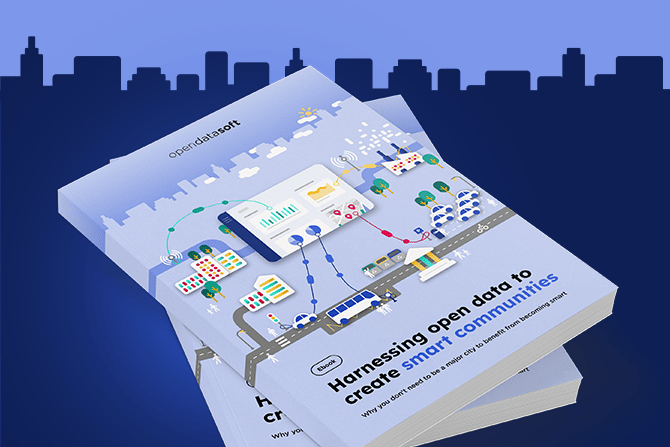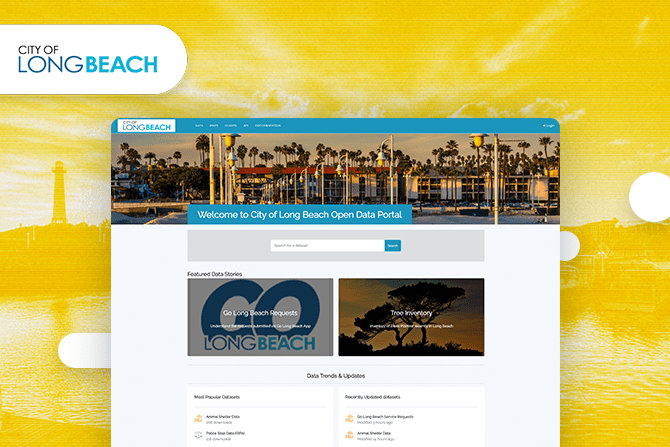How to build smart cities using data and the cloud
Smart cities deliver enormous benefits to citizens, municipalities and other stakeholders. Data and the cloud are the foundations of successful smart cities - we explain how you can harness them to deliver effective, efficient and agile smart cities.

In an increasingly urban world, there’s a need for cities to become smarter to improve public services, enhance efficiency, and deliver greater transparency internally and externally.
But how do you create a smart city and where do you start? What technology do you need and what challenges do you face? How does the cloud help support your plans?
Putting in place the right smart city foundations
Data and the cloud are the essential building blocks for smart cities. Often, data, such as from Internet of Things (IoT) sensors and business systems, is already being collected, but its use is limited to specific departments and teams. Through cloud-based data portals, cities can share this data internally with the rest of the organization and externally with citizens, businesses and other stakeholders to drive efficiency, transparency and innovation. The cloud streamlines the process of storing data, connecting systems and scaling solutions to meet demand, driving greater flexibility and efficiency.
To help cities become smarter, Opendatasoft and AWS partnered to deliver an in-depth smart city webinar, illustrated with examples from their joint North American customer base. By demonstrating both technical proficiency and proven customer success, Opendatasoft is just one of 15 companies worldwide that has achieved the global AWS Smart City Competency.
5 key areas to focus on for smart city success
1. Understand that any size city can become smart
In the past only the largest cities could afford the necessary infrastructure to become smart. But as the price of technology, such as sensors and networks, has dropped and deployment has become easier, every size community can benefit from becoming smart. Driven by data and the scalability of the cloud, they can embrace technology to meet their objectives.
The perfect example of this is the Town of Morrisville in North Carolina. A recent double winner at the Smart Cities Connect Smart50 awards, Morrisville is focused on efficiently using technology and data to enhance the lives of its 30,000 residents.

Its Smart Morrisville smart city program has already delivered a range of innovative projects built on the Opendatasoft platform since the partnership began in 2019. These include smart sports pitches with in-built IoT sensors that automatically close if they are too wet to use, to building permits and sustainability data stories. It recently launched its own app, Morrisville Central, which centralizes data from multiple platforms to provide residents with all the information they need about their community.
2. Leverage the power of the cloud
Along with data, the cloud underpins smart cities. In the past cities had to build and maintain their own data center infrastructure, adding to costs and making it difficult to scale quickly if their needs changed. By switching to the cloud, they can simply and easily access the exact resources they require. This enables greater agility, brings down capital investment, and allows cities to focus on innovation.
The City of Long Beach in California leverages the power of the cloud to share data via a single portal in a user-friendly way from across its different business systems.

For example, data from Long Beach’s 311 Salesforce system is shared on its portal through maps and visualizations. This covers incidents reported to the council, such as dumped items, graffiti, or potholes. Making the data available increases transparency and keeps the public informed, such as on the status of incidents. It also improves efficiency as the same information can be viewed by internal staff, without needing additional Salesforce licenses.
3. Put the right pieces in place
Smart city success is about more than just technology. Before beginning programs cities should focus on:
- Culture: building a culture of openness and sharing around data internally, breaking down any barriers between departments
- Problem-solving: ensuring that smart city use cases solve real problems for citizens and internal staff
- Accessibility: sharing data in ways that it can be easily understood by everyone, not just data specialists
The Californian city of Salinas shares up-to-date information both externally and internally in relevant, usable ways as part of its aim to become truly data-driven. One notable use of data is to underpin the Community Alliance for Safety and Peace (CASP) program, a community initiative involving multiple groups to target youth and gang violence. This uses data, such as on crime rates and school performance to structure the program and monitor progress. The program has reduced youth violence by over 60% in the last decade.

4. Take a step-by-step approach
There are a vast range of use cases for smart city technologies, making it tempting to take a ‘big bang’ approach that tries to do everything at once. However, this is likely to spread resources too thinly and slow down implementation times. Instead, talk to internal and external stakeholders, understand their needs and look at the use cases that deliver the best ROI. Launch pilots, communicate and analyze the results, and expand from there.
The Town of Cary in North Carolina is taking this step-by-step approach. It has focused on specific use cases over the course of its smart city program, with all data shared through its portal. It began by analyzing wastewater for traces of opioids to better target interventions, then launched an early warning system for flooding with sensors and rain gauges. Recently it made data sharing a central part of its CASSI autonomous shuttle trial, informing the public about the program and gathering data on the pilot.

5. Overcoming obstacles
As with every new project, you need to convince stakeholders within the city or municipality of its benefits in order to unlock investment. They are likely to have four key questions:
What happens if it goes wrong?
Taking a step-by-step approach and piloting will help de-risk projects. However, if specific use cases don’t go fully to plan be open and transparent, sharing data and using it to learn from.
How do you ensure everything works together?
Working with cloud-based solutions such as AWS and platforms such as Opendatasoft makes it easy to connect different systems and data sources. Take an ecosystem approach based on openness and APIs.
What about security and privacy?
Be transparent on your security policies and what data is being collected. Using a cloud platform provides in-depth security expertise, increasing confidence for all.
How do you get people to actually use data?
If you start with focused use cases, people are likely to have a need for particular datasets. Then ensure it is accessible and understandable through compelling visualizations and an easy to use portal.
Where to start with your smart city
Learn more about creating an effective smart city program by watching the full webinar, with additional customer use cases, best practice advice from AWS and Opendatasoft, and an in-depth Q&A. Access it here.




